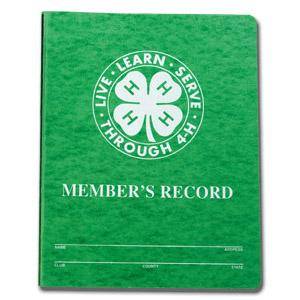4-H Record Book
The 4-H program has a long history of record keeping. The focus reflects the importance of this life skill in our daily lives. In 4-H, young people have tracked their activities, events, profits and losses, skill development and learning experiences, and much more using the iconic 4-H Record Book. In addition to record keeping, the 4-H Record Book gives members an opportunity to reflect on their year, measure their achievements and growth, and set goals, and develop plans to meet those goals.
Why have 4-H record books?
4-H Record Books serve a variety of purposes in the Gallatin 4-H Youth Development Program.
- 4-H Record Books give members an opportunity to reflect on their yearly work. They document their skill development and their learning experiences in a written report. 4-H members measure their achievements and growth in their total years in 4-H.
- 4-H Record Books encourage members to set goals, pursue strategies to meet those goals, and to shift gears in the face of challenges and obstacles.
- Completing a 4-H Record Book is a process where 4-H members record project and club work. Records management is a competency skill to identify, create, classify, archive, and preserve records. The 4-H Record Book teaches 4-H members these skills through a standard format.
- In order to participate in the fair each summer, youth must show a completed record book to an interview judge.
Record Book Forms:
| PRINT VERSION- The following record book forms are meant to print off before use. |
| My 4-H Year |
| Non-Animal Project Journal & Financial Record |
| Animal Project Journal & Financial Record |
| Cloverbud Record Sheet |
| Archery Project Journal |
|
ZSUITE DIGITAL VERSION- ZSuite is a mobile-friendly website that mirrors the Montana 4-H record sheets. Note that it is not an App. After entering all of your record keeping for My 4-H Year, Non-Animal Projects or Animal (Market or Non-market) Projects you can download a printed version that looks nearly identical to the Montana 4-H Record Sheets found here. You can save your progress throughout the year, add records on-the-go, and print a neatly typed version for submission at the end of the 4-H year. |
| ZSuite Record Book How-To Video |
| Example of Digital ZSuite "My 4-H Year" |
| Example of Digital ZSuite "Animal Project Journal & Financial Record" |
|
ELECTRONIC VERSION- The following 4-H record keeping forms are interactive Adobe PDF files. They can be saved to your computer for electronic use throughout the year (you can type your record information right into them and they include calculating functions).YOU MUST Save each file to your computer FIRST to use form functions. Do this by right-clicking and using the 'save link as' function. If you choose to save them for electronic use you must have version 7 or higher of Adobe Reader. Download the latest version of Adobe Reader. |
| My 4-H Year |
| Non- Animal Project Journal & Financial Record |
| Animal Project Journal & Financial Record |
What are the requirements for a completed Gallatin County 4-H record book?
Record Book & Interview Scoring Process
1. Turn In Completed Record Books to Office
- Record Books: Upon turn-in of your Record Books, Project & Club leaders will sign, review and score
your records based on completeness, content and project standards utilizing a record
book rubric. (This will be your Record Book score).
- Completed Record Book DUE: Last Wednesday of June
- My 4-H- One per youth, per year.
- Non-Animal Project Journal - if you are bringing a non-animal project to fair.
- Animal Project Journal - if you are bringing an animal project to fair.
- Project Workbook- Most all 4-H projects have a curriculum book issued through 4- H Office. (7 activities required each year)
- Completed Record Book DUE: Last Wednesday of June
2. Interview in each Department you are entering.
- Interviews: During the Project Interviews prior to Fair, a judge will evaluate members on their
interview skills (eye contact, confidence, attire, ability to answer questions), their
4-H Year experience and project knowledge utilizing an interview rubric. (This will
be your Project Interview score).
-
Interview in each Department you are entering in the Fair:
- Livestock/Small Animal (Dog included) and Horse Project Interviews (Thursday & Friday before Fair Week)
- Indoor Project Interviews & Exhibit Judging (Monday of Fair Week)
- Project Interview Scoring Rubric
-
3. Project Award Nomination Process
- Composite Score: The Record Book score (max points = 82) and the Project Interview score (max points
= 48) will be totaled together for a Composite Score (max points = 130).
- Members with a Composite Score of 80% or higher will get nominated to be considered for a Project Award. Those nominated will be asked to re-turn in their completed Record Books in September for final review. Project Awards are presented at the end-of-year Awards Banquet

